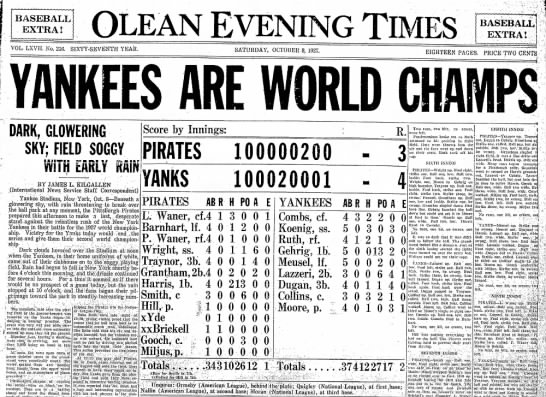Sports Articles: GREAT TEAMS PART 3: The 1927 New York Yankees Baseball Team
Image from: freelargeimages.com
Great Teams Part 3
Murderers Row: The 1927 New York Yankees Baseball Team
"The way a team plays as a whole determines its success. You may have the greatest bunch of individual stars in the world, but, if they don't play together, the club won't be worth a dime." - Babe Ruth
The story of arguably the best team in the history of the MLB started a long time before 1927, as the first building blocks were put in place in 1915. That was when Tillinghast L'Hommedieu Huston (known as Cap Huston) and Jacob Ruppert became co-owners, buying the ball club from Frank J. Farrell and William S. Devery. Ruppert was a beer tycoon who inherited a secure fortune that meant he had no need to do what most owners of the time did. Instead of using the Yankees as an ATM, Ruppert reinvested profit back into the club, even when prohibition badly affected his breweries.
It was also the year that the first member of the team was signed, when Bob Shawkey joined from Philadelphia Athletics for $18,000 on 7th July. The most important thing that Ruppert did was to bring in two men to run the club's day-to-day business in general manager Ed Barrow and manager Miller Huggins who were responsible for turning the ball club into a powerhouse of the sport of baseball. Though it was not a smooth ride to the top, as the ownership disagreed over the appointment of Huggins, as Huston wanted his drinking and hunting buddy Wilbert Robinson to fill the role.
Huggins was a small man, just 5' 6" tall, who was known for being strict, from banning smoking while in uniform to his tendency to quiz players on the bench on what was going on in the game to make sure they were following the game closely. He was also a great judge of character who could help to develop it who was unhappy with the St Louis Cardinals, after being beaten by what he considered underhand dealing when he tried to buy the team and at not being given the credit he deserves for the team's performance.
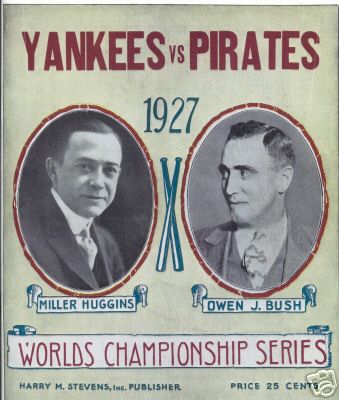
Oddly Huggins also had a law degree but never practiced law. However, when Ruppert met him and made him an offer, which Huggins accepted in October 1917, it caused a rift with Huston, which saw Huston take an immediate dislike to Huggins. The rift got so large that, in 1922, Huston retired and sold his share in the club to Ruppert for $1.5m. The 3rd member of the team, Edward Grant Barrow, who became known to the players as 'Cousin Ed', bought a 10% stake for about $300,000.
"I say there has never been a smarter baseball man than Mr. Barrow. He knows what a club needs to achieve balance.....I, perhaps, can judge the part; but Mr. Barrow can judge the whole." - Branch Rickey
Barrow was born in a covered wagon, but went on to become one of the key components of the Yankees dynasty. A sportswriter, Joe Williams wrote later: "The Ruths had done the hitting, the Pennocks the pitching, the Dickeys the catching, and the Lazzeris the fielding, but it was Barrow who knitted the organisation together, gave it a pattern and a far-seeing program....That's why Barrow's hiring in 1920 'represents the best deal the Yankees ever made.'" On his arrival Barrow told Huggins: "You're the manager, and you'll not be second guessed by me. Your job is to win; mine is to get you the players you need to win."
In his 26 years with the Yankees he won 14 American League pennants and 10 World Series, but one of his biggest contributions was made before he even joined the ball club. It was Barrow, while the Boston Red Sox general manager, who moved from the pitcher's mound to the outfield. He boasted about it later: "Many people have said that 'with that move' I changed the whole course of baseball." He was so highly rated that he was approached three times in the winter of 1923-4 alone by the Washington Senators, but he rejected each approach. Though he was helped by Ruppert's approach of allowing the club to fund itself, which enabled the Yankees to maintain the highest payroll in the sport and use the income from boxing matches and american football games played at the Yankees Stadium to increase the coffers.
Barrow built a roster that consisted of seven who would go on to make the Hall of Fame, Herb Pennock, Waite Hoyt, Lou Gehring, Tony Lazzeri, Babe Ruth, Earle Combs and the manager Miller Huggins. The batting line up was so scary that the nickname originally coined for the 1918 Yankees became synonymous with them, 'Murderer's Row', which refers to the first 6 batters. When it is used now, people only think of the 1927 team. 1927 also marked the first time that the Yankees nickname was acknowledged on their uniforms, though only the road ones, as the home ones had just NY on the caps.
Full roster:
Pitchers: Walter Beall, Joe Giard, Waite Hoyt, Wilcy Moore, Herb Pennock, George Pipgras, Dutch Ruether, Bob Shawkey, Urban Shocker, Myles Thomas
Catchers: Benny Bengough, Pat Collins, Johnny Grabowski
Infielders: Joe Dugan, Mike Gazella, Lou Gehrig, Mark Koening, Tony Lazzeri, Ray Marchart, Julie Wera
Outfielders: Earle Combs, Cedric Durst, Bob Meusel, Ben Paschal, Babe Ruth
Coaches: Art Fletcher, Charley O'Leary
"In the daytime you sat in the dugout and talked about women. And in the night time you went out with women and talked about baseball. It's great to be young and a Yankee." - Waite Hoyt
Despite the strong line up, the Yankees were not the favourites, having lost the 1926 World Series to the St Louis Cardinals. Despite that a poll of 100 players and another poll of baseball experts both picked the Philadelphia Athletics as the favourites. Connie Mack's Athletics had been rebuilding for years and had signed some key veterans to go for the World Series that season.
There was an early chance to find out how the two teams compared as they faced off on opening day in front of a record crowd of 73,206, which could have been much higher as many were turned away due to a full stadium. Ruth was a huge draw and many wanted to see him face off against the other top player of the time, Ty Cobb. Cobb resented Ruth, the way he played, his lack of physical conditioning and his overwhelming success and fan love. There was genuine needle between the two.
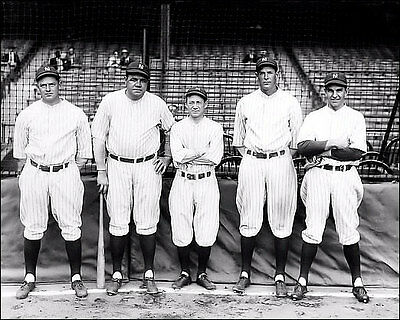
His resentment can only have increased when, on Ruth's first bat the Mayor, Jimmy Walker, appeared on the field, stopping play to a chorus of boos from the crowd for doing so, to present Ruth with a silver loving cup for being voted the most popular player by William Randolph Hearst's newspapers. Cobb would not be feeling any better by the end of the game as, despite Ruth being pulled out of the game in the 6th innings with a bilious attack, NY won 8-3, serving notice that they were genuine challengers again this season. The next 3 games were the completion of a 5 game series against the A's, which the Yankees swept, winning 4 and drawing 1.
The Yankees were top of the American League, a place they would not relinquish, with most of the attention focused on who would be the home run champion and then if Babe Ruth could break his record of 59 that he set in 1921. Ruth himself was doubtful he could beat it: "I don't suppose I'll ever break that 1921 record. To do that, you've got to start early, and the pitchers have got to pitch to you. I don't start early, and the pitchers haven't really pitched to me in four seasons. I get more bad balls to hit than any other five men......and fewer good ones." In mid-season Ruth was behind team-mate Gehrig, Ruth later said that he thinks that made the difference: "Pitchers began pitching to me because if they passed me they still had Lou to contend with."
The Yankees flew through the regular season, running over teams in such a way, after a game against the Washington Senators in July which ended in a 21-1 victory for NY, Sens 1st baseman Joe Judge said: "Those fellows not only beat you but they tear your heart out. I wish the season was over." Despite the New York World Telegraph making Gehrig favourite by mid-season, Ruth was home run champion breaking his previous record of 59 in the next to last game with number 60. An exultant Ruth was heard shouting after the game: "Sixty, count 'em, sixty! Let's see some son-of-a-bitch match that!" Ruth managed 17 in September alone to hit more home runs than any other team in the American League managed in total.
The Yankees won the American League with a 110-44 record, their 5th pennant, finishing 19 games ahead of the second placed Athletics and 59 ahead of the Boston Red Sox. Their victory total broke the previous record in the AL of 105 which was set by the 1912 Red Sox and stood until 1954 when the Cleveland Indians, benefitting from playing more games, broke it. They had outscored their opponents by 371 runs and his 158 home runs with only 1 other team getting over 100, the NY Giants who got 109. Lou Gehrig was the AL MVP as there was a clause prohibiting repeat winners and Babe Ruth already had an MVP trophy in the AL.
There became a legend surrounding the Yankees '5 o'clock lightning' that they won games with late bursts to destroy opponents. With games beginning at 3:30, and games lasting just under 2 hours, the name became enshrined in folklore. It was enough to take them into the World Series to face Pittsburgh Pirates, where another legend was born. The legend claims that the World Series was won before it even started when some of the Pirates were so awestruck by watching the Yankees doing their batting practice the day before game 1 that they mentally threw in the towel. Whatever the truth of that is, the Yankees swept the series, winning 5-4 and 6-2 at the Yankees Stadium, then 8-1 and 4-3 in Pittsburgh to become World Series champions.
"The backbone of any ball club is the pitching staff. The New York Yankees are sometimes spoken of as an exception. I have heard it said their tremendous batting punch carries them through. Now, I appreicate that batting punch as much as anyone, but no team would lead it's league as we did in 1927 unless they possessed some real pitching strength." - Miller Huggins
While the season itself was almost a stroll in the park, with the Yankees batting all-comers aside, so to speak, it was a long road building up to this remarkable season, with many bumps in the road. Most of those bumps came from baseball's biggest star, the 'Sultan of Swat' George Herman Ruth, better known as Babe Ruth. When the big hitter first joined the MLB he was a left handed pitcher, until summer 1919, when Barrow removed him from pitching duties so that he could concentrate on his hitting.
Ruth was becoming a problem to the Red Sox as his fame seemed to go to his head and his ability to draw in the crowds had been shown on an exhibition tour across America with the White Sox's Buck Weaver earning him $10,000, almost as much as his year's salary. Despite only being 1 into a 3 year contract, Ruth decided he was grossly underpaid and he told the press that he would get a new deal on double money or sit out the 1920 season. The money he was demanding would put him level with the man then considered to be the greatest player of all time, Ty Cobb, who had just won a record 11th batting title in 13 years.
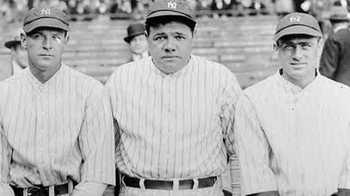
Ruth told 'The Sporting News' that: "I'm the best drawing card in the game now. Ty Cobb's salary is $20,000 a year and I intend to get the same money. You can say for me that I will not put on a Boston uniform next year if I don't receive twenty thousand iron men." Clearly the rivalry that Cobb felt towards him was reciprocated, as Ruth was putting himself up against Cobb with his demands. However, Ruth's actions were not going down well in Boston. His team-mates and manager were unhappy with him, as he was problemative, testing team rules, undermining his manager, refusing to pitch sometimes and skipping the Red Sox's final game of the season in Washington so that he could take part in a lucrative exhibition game in Baltimore.
Red Sox owner Harry Frazee was particularly upset as he had held a day in Ruth's honour in September and given him a $5,000 bonus. The Boston press were portraying Ruth as selfish, arrogant and ungrateful. Added to that his private life showed an extreme appetite for excesses in life - nightly parties, heavy drinking, extra-marital affairs and car accidents. In fact, while Barrow was manager at Red Sox, Barrow had once burst into his hotel room at 6am, on an away trip, to find Ruth fully dressed cowering under the bedclothes after just returning from a night out, well after curfew. Barrow threatened to 'thrash' his star.
With attendances dropping and money tight personally, Frazee needed to raise funds and put Ruth on the trading block. With no trade being able to be made between the two ball clubs, Frazee agreed to sell Ruth to the Yankees for cash and also a personal loan of $300,000. Barrow told Frazee, "you ought to know you're making a mistake." However, against Barrow's better judgement, Frazee made the a deal to sell Ruth for a figure of $100,000, though there were numerous clauses included in the six-page memorandum that was attached to the standard one-page agreement to transfer the player.
The $100,000 was a record price ever paid for a baseball player, almost twice the previous highest. However there were a number of clauses that needed to be fulfilled for the deal to be completed. If Ruth did not report to the Yankees by 1st July the deal was off and any cash already paid would be returned. If Ruth demanded more money and the Yankees deemed "it necessary to increase such salary in order to retain the services of said player" then the Red Sox would have to contribute. And if Ruth demanded more in the form of a "bonus" then Boston would be obligated to pay a portion above the amount stipulated. The whole deal was contractually contingent on Ruth agreeing or it was off.
Huggins travelled across the country to meet with Ruth to persuade him to join. The slugger was tracked down to the golf course and Huggins settled down to wait for him on the clubhouse porch. When Ruth finished his round, Huggins intercepted him but Ruth tried to excuse himself, saying he had a previous engagement he needed to attend. He was not to escape the Yankees clutches so easily though and Huggins offered to drive him where he was going. The pair chatted in the car, Ruth wanting to know how much he would be paid, Huggins emphasising that Ruth would be expected to behave in NY. The pair haggled and, according to Huggins, a deal was done by 5 o'clock that would see Ruth honour his Boston contract and, in return, the Yankees would give him a pay rise.
That same day, 5th January 1920, the deal was announced publicly, with New York papers reporting it as $125,000, while Boston's reported the correct figure of $100,000. Boston had need of the money to stay solvent, though the Yankees immediately doubled Ruth's salary to $20,000 in the form of instalment bonuses, which would have meant the Red Sox were liable for a portion. There is no record of them actually being held to that part of the contract though. At first things went well and he even adopted a personal mascot called 'Little' Ray Kelly, a toddler in 1921 who would sit in the dugout during home matches, and continued to do so for years to come.
Then things began to turn sour, with Ruth playing up to the point that Huggins fined him $5,000 and suspended him in August 1925, and his weight had risen alarmingly. 1926 saw Ruth back to his best though but it just led to fresh salary demands ahead of the 1927 season, when Ruth asked for $100,000 a year. The media loved the story and bombarded Ruth with questions as the star stopped off in Chicago on the way back to New York for spring training. He had spent the winter filming a movie and working with his personal trainer Artie McGovern to get into shape for the new season. Ruth was happy to pose for photographs and answer questions, saying: "There isn't much I can say about it. Either I get it or I don't. I have asked for $100,000 and I see no reason why I should accept less."
Ruppert, who usually left running the Yankees to Barrow and Huggins, did get involved in a contract as big and important as Ruth's, was a little less amenable than Ruth with the press. When asked if he was going to give Ruth a new deal he said: "We have no engagement to see Ruth. He will have to call up and arrange an appointment like any of the other players."
"It's always the same, Combs walks, Koenig singles. Ruth hits one out of the park. Gehrig doubles, Lazzeri triples. Then Dugan goes in the dirt on his can." - Joe Dugan
The press speculated that Ruth would end up accepting less than $100,000 and would be likely to just get a 1 year deal as he did not perform so well when safe with a long term contract. However Ruth was a changed man from the wild hellraiser of former years. He was estranged from his wife, who suffered from mental health problems, but on friendly terms with her. Being religious he refused to consider divorce, but he had settled down, to a large degree, with a widower who had a 10 year old daughter. It was the influence of the widower and her daughter that is credited with calming Ruth down.
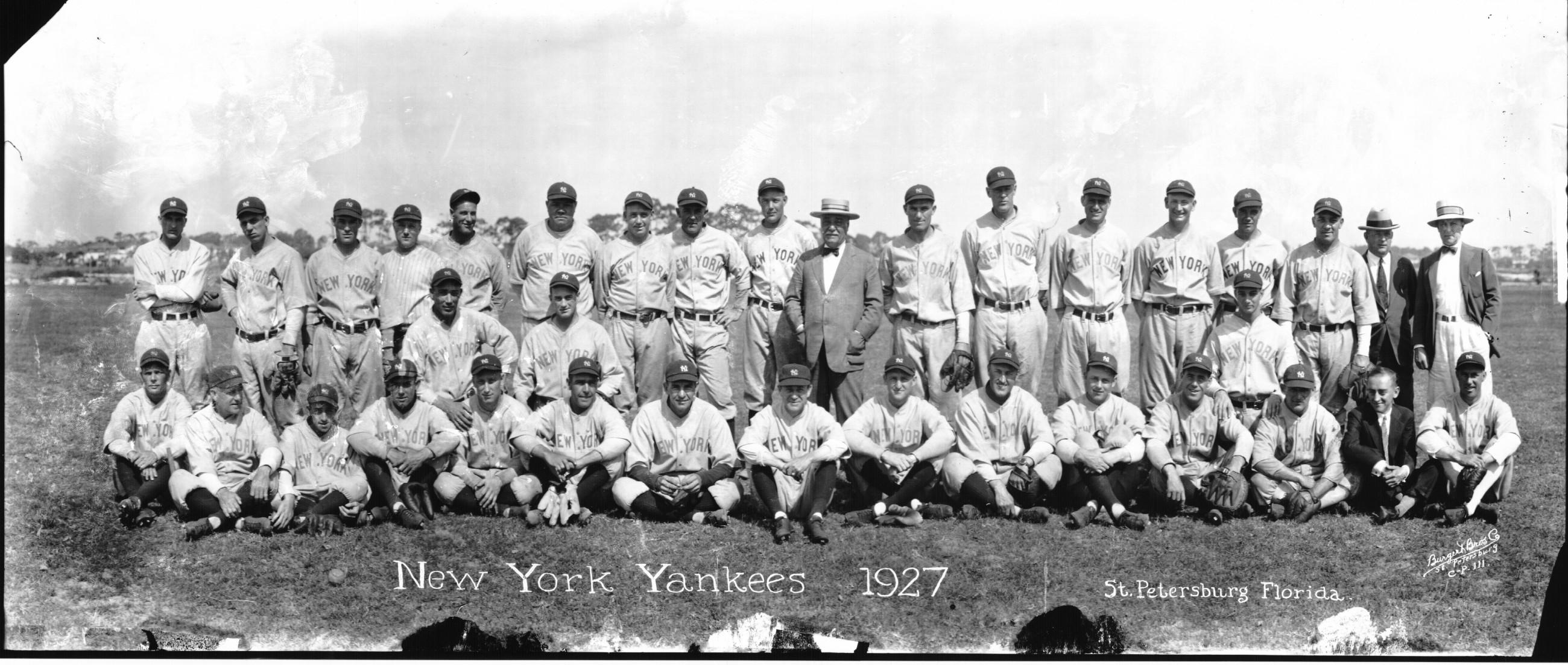
The Yankees management were impressed by Ruth's fitness, he had lost 8 inches off his waist over the winter break and Ruth told Ruppert: "I have worked harder in the past 4 weeks than I ever did in my life. This making a moving picture is no joke. Maybe you think it's all play, but take it from me, it is nothing but twelve to fifteen hours hard work everyday. I never had an hour to myself from the minute I started until I left town. I'm mighty glad the picture is finished and I am anxious to see it. I think I will make a hit as an actor." "You will make a bigger hit as a ball player," replied Ruppert, which gained him a laugh from Ruth.
At 1pm Barrow, Ruppert and Ruth shut the doors on Ruppert's office and settled down for contract talks. Less than an hour later the trio emerged and Barrow invited a group of sportswriters into the conference room where Ruppert announced Ruppert announced proudly: "Babe Ruth now is the highest paid man in baseball. We came to terms without any trouble. Babe will go to camp on Saturday and everything is fine." A 3 year deal at $70,000 per year, a 35% pay rise for Ruth and beating the record deal Ty Cobb had agreed just a month earlier, making Ruth the highest paid man in baseball. It was $5,000 more than MLB commissioner Landis, who ran all of baseball, and a mere $5,000 less than the President of the United States Calvin Coolidge was paid for running the country! The average American family of the time earnt just $1,300 per year.
Ruppert continued: "I pointed out to Ruth, that his loss would be as great as ours if he ever quit baseball, and that movie contracts wouldn't be so freely offered in such a contingency. The Babe is a sensible fellow. Our talk was cordial, businesslike and, as you can see, very much to the point and successful for both of us. It's a big gamble with me, but I am convinced that Ruth, a remarkable fellow physically, won't make me sorry. He thinks he has five more years of baseball in him and I believe he is right. I am sure he will take better care of himself now than he ever has. He isn't growing any younger, and he realises it."
Ruth said he was keen to get back to training and playing baseball: "I like the movies but I would rather play baseball than anything else I know of. I know I have a lot of good baseball still left in my system. You fellows won't be able to play taps over Babe Ruth for five or six years yet, that I am willing to bet on. I figure I will have a mighty fine season. Gee whizz, everything points that way. My mind is at ease and I feel fine. I guess Huggins won't know me when I get into camp. I will get off the rest of this excess weight and by the time the exhibition games start I will be in prime shape."
Ruth's deal did have a knock-on effect, as several other players received substantial pay rises too, though the second highest player, Herb Pennock, was paid just $17,500. Ed Barrow and Miller Huggins combined were to earn less than Babe Ruth that year, but Huggins said: "If any figure in baseball ever has been worth pay like that it is Babe Ruth.....Of course, no other player ever could have been worth any such sum, or any sum approaching it. But everyone admits there is only one Ruth, and baseball may never see his like again. He is the master showman, and the club can afford to pay him a figure because of his tremendous drawing powers."
It certainly turned out to be a good decision for the Yankees, with Ruth winning 7 World Series and becoming the first player in MLB history to hit 200, 300, 400, 500, 600 and 700 home runs! It is little surprise that he was elected to the baseball Hall of Fame as part of the inauguaral group of inductees on 2nd February 1936. He was arguably the greatest player of all time with a home run record that would only be beaten when the number of games was increased. His performances were so good that the word 'Ruthian' has become an adjective in the US to describe performances of heroic performances!
It was not all about Ruth though, Gehrig was a great player in his own right, coming second in home runs (hitting more than half of the teams managed in total!) and scoring a then record 175 RBIs (Run Batted In - when a batter hits the ball and it results in a run being scored, such as by a man waiting on 3rd base). The pitching staff led the league in ERA (Earned Run Average) and the Yankees were the only team to have top 4 pitchers in winning percentage. Centre fielder Earle Combs had a career best year and left-hand pitcher Herb Pennock retired the first 22 batters in order during the 3rd game of the World Series. It was a team effort, Ruth just stood out as the, probably, greatest player of all time should do within even a great team.
"Those Yankees were the best team. Figure it out. After we got going we won twelve straight World Series games - twelve in a row. It was murder. The Yankees had the greatest punch baseball ever knew. We never even worried five or six runs behind.....Wham! Wham! Wham! Wham! And wham! No matter who was pitching." - Julie Wera
There was also left fielder Bob Meusel, whose brother Irish also played in the MLB, who came through at the Yankees in 1920. He batted .337 with 103 RBIs in the season and was one of the higher paid players, though nowhere near Babe Ruth, with a $13,000 salary. Second baseman Tony Lazzeri managed to drive in 102 runs despite suffering from epilepsy. Lazzeri, who hailed from San Francisco, had only made it into the big leagues in 1926 with the Yankees. His $8,000 contract was notable for the fact that it included an added on clause of a round trip train far for he and his wife to get them there for the start of each season and home at the end. Sadly Lazzeri was one of a number of people connected to this team that died young when he was found dead in his San Francisco apartment at the age of 42 in 1946. It is believed he had suffered a massive coronary and slipped on the stairs banging his head on the bannister.
Waite Hoyt made a big contribution as well, with a 22-7 record ensuring he got his $1,000 bonus he was due for reaching 20 wins. He was one of a number of players who arrived from Boston, which was a rich seam of talent for the Yankees to tap into, Hoyte joining as part of a multiplayer trade in December 1920 after his second MLB season. Herb Pennock the man who wrote the 10 commandments of pitching, literally, was a huge part of the team, not just for his performances on the pitch. Pennock missed out on a $1,000 bonus he would have got for reaching 25 wins, as he only managed 20, but he was a big help to Babe Ruth. The pair had been friends since they were young pitchers together in Boston.
While Ruth was raised in an orphanage for the poor, Pennock was from a wealthy Pennsylvania family and had graduated from exclusive prep schools. Ruth was a hard-drinking, womanising, boisterous carouser, while Pennock was known as a refined and dignified gentleman, yet the pair were close friends. Ruth would get advice from Pennock whenever he was in a batting slump and Pennock was well known for his knowledge and understanding of the art of pitching. "If I had one word to describe Pennock, it would be class," Ruth once said of him and it is difficult to argue. Pennock never lost a World Series game in his entire career, so his price of three players and $50,000 in cash that the Yankees paid in 1923 for him can probably be termed a steal. He collapsed in the Waldorf Astoria and died of a cerebral brain haemorrhage in 1948. Pennock was working as the general manager of the Phillies at the time and was just 53 years old.
Late bloomer Wilcy Moore was is his rookie season at the age of 29, made his debut in the same game as Julie Wera did, won 16 games as a reliever on his way to a $500 dollar bonus for finishing the year with the ball club. Just reaching the World Series could double the salary for the fringe players, which kept many of them with the team, as the large capacity of 62,000 that the Yankees Stadium had increased their payout due for qualifying. Added to that, each player took a World Series winner's share, which was a cheque for $5,592.17 in this season. In Moore's case that more than double his basic salary, which would have been important financially for a man who only began a minor league career when he was 25. His career petered out after this season.
Many of those involved with the team died young, including Babe Ruth, who died in 1948 due to the throat cancer he suffered due to smoking, chewing tobacco and snuff taking. Urban Shocker only manager to pitch 2 innings the following season due to illness, he had been unable to sleep lying down for 2 years and then passed away on 9th September 1928. His death was caused by what was termed "an overtrained athlete's heart".
"Gehrig never learned that a ballplayer couldn't be good every day." - Hank Gowdy
Babe Ruth was not the only legendary player on the team, Lou Gehrig was someone whose star rivaled Ruth's despite his own words: "It's a pretty big shadow (Babe Ruth's) - it gives me lots of room to spread myself. I am not a headline guy. I know that as long as I was following Ruth to the plate I could have stood on my head and no one would know the difference." Despite those words Gehrig's career, entirely spent with the Yankees, was one that put him in the spotlight from the moment he made his debut, replacing Wally Pipp, who had a headache. Pipp would later say, "I took the two most expensive aspirins in history." Gehrig went on to make 2,130 consecutive appearances, becoming the first man to play in 2,000 consecutive games.
Gehrig certainly emerged from Ruth's shadow, not only becoming the captain of the Yankees, but he was also seen as a potential candidate for the role of Tarzan, even going so far as to be screen tested wrapped in a leopard skin. Added to that he achieved many firsts, such as being the first athlete to appear on a box of Wheaties. The first baseball player to have his number (4) retired. The first player to hit 20+ grand slams (he finished his career with 23 in total). The first American League player to hit 4 home runs in one game. The first player to achieve 13 consecutive 100+ runs in a season. His ability led another great of baseball, Joe DiMaggio, to say that, "there is only one answer to that, Mr Gehrig is terribly underpaid," when he was informed that Gehrig earned $1,000 more than him per year!
Gehrig was also known as a nice guy, Sam Jones said of him: "Lou was the kind of boy that, if you had a son, he's the kind of person you'd like your son to be." Sportswriter Fred Lieb also agreed with the assessment: "There was absolutely no reason to dislike him and nobody did." Except it was not quite true, there was at least one man who did not like him, according to teammate Tony Lazzeri and that was Babe Ruth. Lazzeri said: "They didn't get along. Lou thought Ruth was a big mouth and Ruth thought Gehrig was cheap. They were both right."
What Lou Gehrig was, in everyone's opinion, was an exceptional fielder who would turn up and perform game after game. Saying himself: "In the beginning I used to make one terrible play a game. Then I got so I'd make one a week and finally I'd pull a bad one about once a month. Now I'm trying to keep it down to one a season." However that all changed when in 1937 he got sick and Barrow suggested it was time for him to move on, something Gehrig's wife Eleanor never forgave him for. By the end of the 1938 season, Gehrig was beginning to show signs of the illness that would eventually kill him, though no one realised what was happening at the time. Gehrig tried to get his form back but it just got worse, so, at the start of the 1939 season after a few awful performances, he asked then Yankees manager to drop him.
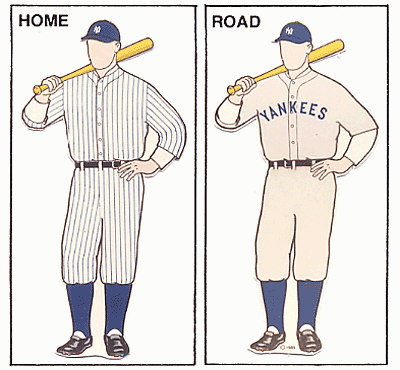
Gehrig was inducted into the baseball Hall of Fame in 1939 but just over two years later, one of the greatest players to grace the baseball field died 17 days before his 38th birthday of an illness that now bears his name - amyotropic lateral sclerosis or motor neurone disease, which is known as Lou Gehrig's disease in the US. It was the 2nd of June 1941, less than 18 years after his debut as a teenager in the MLB. The 7-times All-Star, described as a manager's dream by sportswriter John Kiernan, was gone.
"Gehrig had one advantage over me. He was a better ball player." - Gil Hodges
One of the players that were lost young was back up catched Johnny Grabowski. Grabowski only joined the Yankees for the 1927 as part of the deal that also brought Ray Morehart to the ball club. Grabowski was sadly killed in a house fire in 1946 after he tried to save his car. He was just 46 years old. Joe Dugan was brought in as part of a multiplayer deal from Boston (like so many) in 1922. Dutch Ruether was acquired off wagers from Washington in 1926, a player in his 30s with a reputation for being a hard-headed hellraiser. It was his last season in the Major League.
Earl Combs was called "the first of the great Yankees' center fielders," by sportswriter Harold Friend. He broke through into the Yankees' team in 1924 and had a good career, with 8 consecutive 100+ run seasons. Three times he managed 200 hit seasons. Combs was also the first ever Yankees player to step up to the plate to bat with a number on his jersey, in 1929 when he opened the season with the #1. The man recruited back in 1915, Bob Shawkey, was at the end of his time and this would be the final season in the major leagues for a man who was once said to have the hardest arm motion of any major league pitcher. Shawkey also doubled up as a pitching coach in the 1927 season.
"I think this stuff (hair restoring ointment) works. Every time I use it, I get a headache. I think that means that hair is trying to break through." - Benny Bengough
The team did have a weakness, there were no top class catchers in the side, with the third choice catcher Benny Bengough being still at the ball club mainly because he was Gehrig's room-mate and went hunting and barnstorming with Babe Ruth. Bengough, who was nicknamed 'The Peter Pan of Baseball' because he was short and slim like a child, was limited by an arm injury he had picked up the previous year and it limited his innings for the rest of his career.
Pat Collins had not played since 1924 with the St Louis Browns when he was picked up by the Yankees in 1926. Another player who had not played for a while was Ben Paschal who was also signed in 1924 but he had not played since 1920 with Boston. Myles Thomas was a late developer only breaking into the big leagues the previous season for the Yankees at the age of 28. There were so many who outperformed their previous, including Ray Morehart, who hit his only home run of his career in 1927. In fact the returned straight back to the minor leagues afterwards.
George Pipgras was another who contributed to the victory but his career ended early after a broken arm in 1935. He went on to become an umpire, one of few who had experience of the World Series both as a player and an umpire. Walter Beall pitched just one inning! Joe Giard was at the end of his majors career and only joined ahead of the season in a deal along with Cedric Durst.
Julie Wera hit the only home run of his career in 1927, having only broken through at the start of the season. He returned to being a butcher when he left the Yankees, something he was doing before his baseball career started. However Wera is probably better known from the mistaken news reports in 1948 about his suicide, which must have been a surprise to him, as he lived on until he was 75! The suicidal man had spent a year pretending to be Wera, before committing suicide.
The so-called curse, which saw a number of the players die young, also claimed a number of the staff around the club. The hunchbacked bat boy Eddie Bennett, who had been seen as a lucky charm around the club as he joined in 1921 just as they started winning the American League, died in 1935 at the age of 32 due to his alcoholism. Manager Miller Huggins only lived a further couple of years after the triumph, dying in 1929 after being hospitalised with a boil bear his eye. His condition worsened quickly and, at the age of 51, his death was attributed to the skin disease St Anthony's Fire.
10 years after Huggins passed, the owner Jacob Ruppert, whose willingness to invest in the team was a huge part of its success, died of a heart attack, though he did reach 71 years old. His fortune, a huge for the time $60m worth, was left to three women. His two nieces and a 37 year old chorus girl called Helen Winthrop Weyant who said she "had no idea why he left me so much money".
Maybe the biggest key to the Yankees' success, not just in 1927 either, was Barrow. Converting Babe Ruth from a pitcher was just one of a number of changes he made. It was he that put the numbers on the players' backs. It was also Barrow who initiated the practice of retiring numbers. And he was one of the first baseball execs to allow the crowd to keep foul balls that they caught. Along with that, Barrow initiated the tradition of playing the national anthem before each game. Most importantly of all he was a tough negotiator, Waite Hoyt saying of him: "He knew were to look for leaks in the cashbox, could estimate his costs within a few dollars, and was a sharp trader."
What is clear though, above all else, is that they won because they were a team that worked together. Barrow, Huggins and Ruppert, in the backroom, were a harmonious group that put together a great team to play ball and they were a team, with individuals harnessed together around a couple of the greatest players ever to play the game. There were weaknesses, but the strengths massively outweighed them and they gained a mental edge over every competitor with the strength of their batting.
"There is no room in baseball for discrimination. It is our national pastime and a game for all." - Gehrig
To read the previous episode in the Great Teams series click HERE to read Part 2 - Orange But No Black: The 1951 USF Dons.
Written by Ed001 February 18 2019 09:08:44
Discuss rumours and transfers on our boxing rumours web page
Discuss rumours and transfers on our MLB rumours web page
